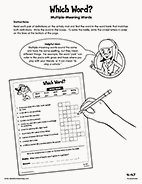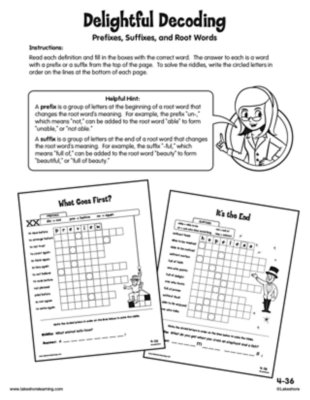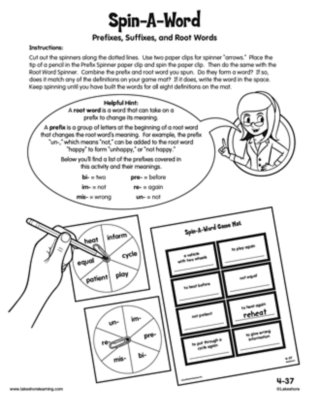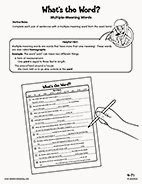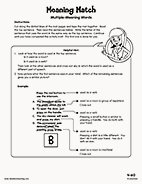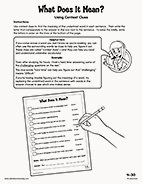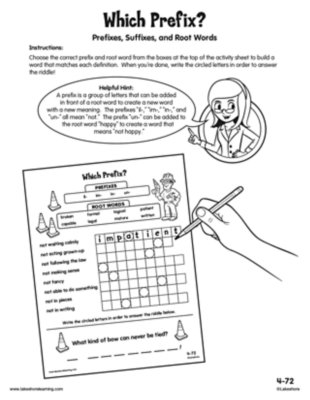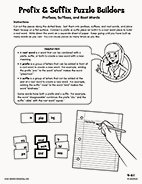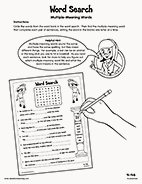Narrow by Grade
- Infant (0)
- Toddler (0)
- Preschool (0)
- Pre-K (0)
- Kindergarten (4)
- 1st (7)
- 2nd (10)
- 3rd (10)
- 4th (10)
- 5th (8)
- 6th & Up (0)
Grade 4th
Narrow by Age
- 0-18m (0)
- 18-36m (0)
- 3 yrs. (0)
- 4 yrs. (0)
- 5 yrs. (0)
- 6 yrs. (0)
- 7 yrs. (0)
- 8 yrs. (0)
- 9 yrs. (10)
- 10 yrs. (0)
- 11 yrs. & Up (0)
Age
10 results for "brights 4 ever cut outs"
When entering fourth grade, your child should be able to figure out the correct meanings of multiple-meaning words that appear in third-grade texts, such as knowing when the word “shower” refers to a rainstorm or a place to wash off.
View worksheetWhen entering fourth grade, your child should be able to figure out the meaning of a word when a prefix or suffix is added to a familiar root word, such as figuring out what the word “unhappy” means based on the knowledge that “un-” means “not.”
View worksheetWhen entering fourth grade, your child should be able to figure out the meaning of a word when a prefix or suffix is added to a familiar root word, such as figuring out what the word “unhappy” means based on the knowledge that “un-” means “not.”
View worksheetDuring fourth grade, your child will be asked to figure out the correct meanings of multiple-meaning words that appear in fourth-grade texts, such as knowing when the word “pitcher” refers to a container for pouring liquids or a person throwing a ball.
View worksheetDuring fourth grade, your child will be asked to figure out the correct meanings of multiple-meaning words that appear in fourth-grade texts, such as knowing when the word “pitcher” refers to a container for pouring liquids or a person throwing a ball.
View worksheetWhen entering fourth grade, your child should be able to use clues within a sentence to figure out the meaning of an unfamiliar word or phrase. For example, in the following sentence, the underlined portion provides a clue to what the word “aviary” means: The zoo’s aviary was filled with owls, bluebirds, parrots, parakeets and cuckoos.
View worksheetDuring fourth grade, your child will learn to use common, grade-appropriate Greek and Latin prefixes, suffixes and roots to figure out the meaning of a word. For example, “telegraph,” “photograph” and “autograph” all contain the Greek root “graph,” which refers to something that is written or drawn.
View worksheetDuring fourth grade, your child will learn to use common, grade-appropriate Greek and Latin prefixes, suffixes and roots to figure out the meaning of a word. For example, “telegraph,” “photograph” and “autograph” all contain the Greek root “graph,” which refers to something that is written or drawn.
View worksheetWhen entering fourth grade, your child should be able to use clues within a sentence to figure out the meaning of an unfamiliar word or phrase. For example, in the following sentence, the underlined portion provides a clue to what the word “aviary” means: The zoo’s aviary was filled with owls, bluebirds, parrots, parakeets and cuckoos.
View worksheetWhen entering fourth grade, your child should be able to figure out the correct meanings of multiple-meaning words that appear in third-grade texts, such as knowing when the word “shower” refers to a rainstorm or a place to wash off.
View worksheet